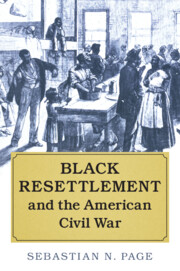Book contents
- Black Resettlement and the American Civil War
- Cambridge Studies on the American South
- Black Resettlement and the American Civil War
- Copyright page
- Dedication
- Contents
- Figures and Maps
- Acknowledgments
- Terminology
- Abbreviations
- Maps
- Introduction
- 1 The Revival of “Colonization,” to 1861
- 2 The Revival of “Emigration,” to 1862
- 3 The Republican Party and Resettlement, to 1863
- 4 Resettlement in Latin America, to 1864
- 5 Resettlement in the European West Indies, to 1865
- 6 Alternatives to Foreign Resettlement, to 1868
- Epilogue
- Index
2 - The Revival of “Emigration,” to 1862
Published online by Cambridge University Press: 21 January 2021
- Black Resettlement and the American Civil War
- Cambridge Studies on the American South
- Black Resettlement and the American Civil War
- Copyright page
- Dedication
- Contents
- Figures and Maps
- Acknowledgments
- Terminology
- Abbreviations
- Maps
- Introduction
- 1 The Revival of “Colonization,” to 1861
- 2 The Revival of “Emigration,” to 1862
- 3 The Republican Party and Resettlement, to 1863
- 4 Resettlement in Latin America, to 1864
- 5 Resettlement in the European West Indies, to 1865
- 6 Alternatives to Foreign Resettlement, to 1868
- Epilogue
- Index
Summary
While always hostile to white demands that they expatriate, free black northerners considered emigrating on their own terms, as an affirmation of their dual identity as black and American. Even as stalwart integrationists such as Frederick Douglass criticized his peers for betraying their enslaved kin, emigrationists such as Martin Delany, Mary Ann Shadd, and James Theodore Holly debated the true purpose of black exodus, as well as the most desirable destination, concurring only in their dislike for the ACS and Liberia. Where to go? Canada, for its proximity to the United States? The Niger Valley, for its connection to their African ancestry? Or Haiti, the one black-run state in the Western Hemisphere, and a bastion of black militancy? As emigrationists duly divided, exploring and settling distant lands, they were shocked to realize just how American, even “Anglo-Saxon” their assumptions really were – and how much they had to call on much-resented white assistance. And so, like white colonizationists, they entered the 1860s praying that some more powerful entity would assume the onerous task of fostering African American emigration.
Keywords
- Type
- Chapter
- Information
- Black Resettlement and the American Civil War , pp. 55 - 98Publisher: Cambridge University PressPrint publication year: 2021



